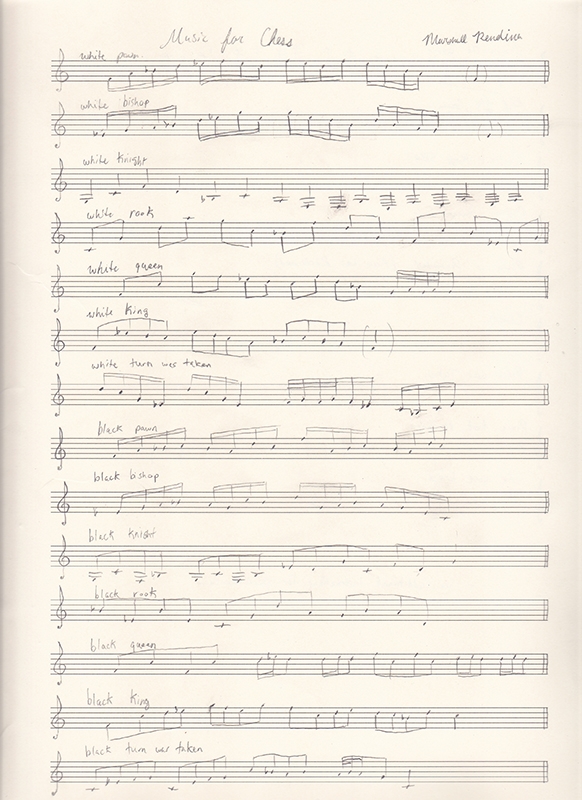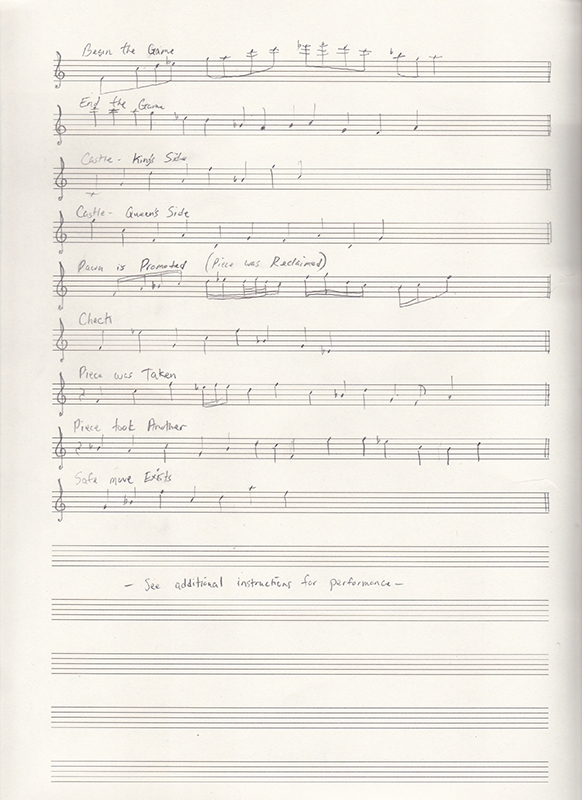Musical Chess
From a 2005 Concept
Instructions
Different versions and concepts for this piece exist: a simplified version for a live performance, and an advanced version for a prerecorded game to be replayed exactly as it was with music or an electronically played game with music generated by a computer.
In the simplified version for live games, we will only consider taking turns, pieces that have moved, pieces that took another, pieces that have been taken, pawn promotion, check, and castling. The positions of the pieces may or may not be considered for pieces that have moved in the live version but comparisons will not be made between pieces.
Each player should take their turn, then go through the events list in any order, decide how many pieces to compare for each event, and alter the starting motifs based on positions.
Motifs may be repeated and fade as the next move is taken so there are no gaps in time where there is no music, and events may be cycled through until the turn has been taken.
Motifs for the Pieces
In either version, each piece will have a motif associated with it. The motif associated with each piece is played as is in the starting position of the piece. In either version of the game, each type of piece for each player will have an associated motif. There will be six motifs for each player: black and white kings, queens, bishops, knights, rooks, and pawns. Other versions of the game may include motifs for each individual piece.
Motifs for the Events
Certain events have motifs associated with them regardless of where the pieces have moved or what pieces have been taken.
A motif for the start and end of the game is optional in either version.
If a turn was taken, that player’s turn was taken motif will be played.
Castling has two motifs that are the same for both players – castling on the queen’s side, and castling on the king’s side.
Pawn promotion has a motif associated with it.
Check has a motif associated with it.
If a piece was taken, the piece was taken motif will be played following the other instructions for that event.
If a piece took another, the piece took another motif will be played following other instructions for that event.
If a safe move exists, the safe move motif will be played following other instructions for that event.
Event Instructions
Begin the Game – play the begin the game motif when the players and performers are prepared to begin.
Turn Was Taken – play the motif for the player whose turn was taken, reversing the motif if time ran out for the turn before a move was taken, and inverting the motif if the turn was forfeited.
Piece Moved – play the motif of the piece transposed for the distance from the last move or start of the game if it is the first move the piece has taken, and optionally take note of where it has been transposed to for future moves.
Piece Can be Taken – decide how many pieces to compare and play motifs from the pieces involved transposing each motif for the distance from the piece that can be taken if more than one, and from one another if comparing two.
Piece Can Take Another - decide how many pieces to compare and play motifs from the pieces involved transposing each motif for the distance from the piece that can take another if more than one, and from one another if comparing two.
Piece Can Take a Safe Move – play the safe move motif and transpose it based on where the safe move is relative to the piece that can take the safe move.
Check – play the check motif, reversing the motif if it is checkmate, after the motif for the move that put the other player in check.
Piece was Taken – at the beginning of the turn of the player whose piece was taken, play the piece was taken motif following the motif of the piece that was taken, modifying the piece’s motif to be played in an alternate mode, with the transposition for the last move of that piece, and reverse the piece took another motif if a pawn was taken en passant.
Piece Took Another – at the end of the player’s turn whose piece took another, play the piece took another motif following the motif for the piece that took another, transposing the piece’s motif for the move and modifying the piece’s motif to be played in an alternate mode, reversing the piece took another motif if a pawn was taken en passant.
Pawn Promotion – play the pawn promotion motif after the motif for the piece that moved to the end of the board transposing for the distance it moved.
Castle – play the king’s side or queen’s side castle motif depending on which side the player has castled on, after a castle move.
End the Game – play the game has ended motif as is if the game ended with a checkmate, reversing the motif if it was a stalemate, and inverting the motif if it was a forfeit.
Other versions of the game may consider pieces that can take another on the next turn, pieces that can defend others, and pieces that can put others in check.
Comparisons of Pieces
When an event calls for comparing pieces, either two pieces are compared with one another, transposing the motifs of both for the distance from one another, being played at the same time, or more than two pieces are compared, playing the motifs at the same time transposed for the distance from the piece to which they are being compared with the starting motif of the piece to which they are being compared or that piece's motif transposed for its position.
Transpositions of Motifs
Transpositions can be chromatic or diatonic depending on the preference of the players and performers, being decided before the game is played.
If diatonic transpositions are used, a mode or key must be selected for the entire piece, or the natural mode in which all the motifs have been written is used. The transpositions are then made stepwise in the mode, with the number of squares moved on x and y axes added together to yield the number of steps to transpose the motif.
If chromatic transpositions are used, a transposing key – not a key signature but x and y axes for transposing the motifs should be selected. This can be one of four symmetrical scales: Dorian: 1-2-b3-4-5-6-b7-8, Middle Eastern: 1-b2-3-4-5-b6-7-8, Major-Minor: 1-2-3-4-5-b6-b7-8, or Melodic Minor b2: 1-b2-b3-4-5-6-7-8. These scales are extended on x and y axes with other diagonal squares adding the intervals of the two axes together.
In either case, the axes extend only in the direction the piece moved – they are not fixed for the whole board, with up being towards the opposite player and king’s side, and down being towards the self and queen’s side, x and y intervals or steps being added together for diagonal moves.
The motifs are transposed for the x and y distances from another piece, the distance they moved from the previous position adding the optional previous transposition, or the distance they moved from the start of the game if it is the first time the piece has moved.

